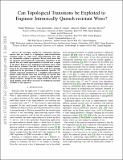Can topological transitions be exploited to engineer intrinsically quench-resistant wires?
Abstract
In this paper, we investigate whether by synthesizing superconductors that are tuned to a topological, node-reconstruction transition point, we could create superconducting wires that are intrinsically resilient to quenches. Recent work shows that the exponent characterizing the temperature dependence of the specific heat of a nodal superconductor is lowered over a region of the phase diagram near topological transitions where nodal lines form or reconnect. Our idea is that the resulting enhancement of the low-temperature specific heat could have a potential application in the prevention of superconductor quenches. We perform numerical simulations of a simplified superconductor quench model. Results show that decreasing the specific heat exponent can prevent a quench from occurring and improve quench resilience, though in our simple model the effects are small. Further work will be necessary to establish the practical feasibility of this approach.
Citation
Whittlesea , P , Quintanilla , J , Annett , J F , Hillier , A D & Hooley , C 2018 , ' Can topological transitions be exploited to engineer intrinsically quench-resistant wires? ' , IEEE Transactions on Applied Superconductivity , vol. 28 , no. 4 , 8252800 . https://doi.org/10.1109/TASC.2018.2791515
Publication
IEEE Transactions on Applied Superconductivity
Status
Peer reviewed
ISSN
1051-8223Type
Journal article
Description
This work was supported by EPSRC through the project “Unconventional superconductors: New paradigms for new materials” under Grant EP/P00749X/1 and Grant EP/P007392/1. The work of P. Whittlesea was supported by a University of Kent 50th Anniversary Scholarship. The work of J. Quintanilla was supported by a SEPnet Fellowship held during the early stages of this work.Collections
Items in the St Andrews Research Repository are protected by copyright, with all rights reserved, unless otherwise indicated.

